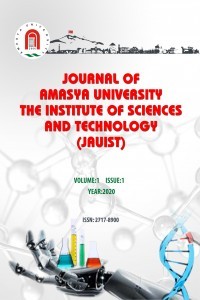QUANTUM CHEMICAL CALCULATIONS OF SOME BENZENE DERIVATIVES
QUANTUM CHEMICAL CALCULATIONS OF SOME BENZENE DERIVATIVES
HOMO-LUMO energies, hardness, Mulliken, electronic and zero-point energy, Mulliken charges of benzene, fluorobenzene, chlorobenzene, bromobenzene, nitrobenzene, cyanobenzene, trifluoromethyl benzene, ethenylbenzene, di, tri, tetra and penta fluorobenzene molecules in gas phase and water phase for neutral and anionic form were calculated with B3lyp/6-31G(d,p) level by using G03 program and also hybridization of these molecules were studied. The Sum of electronic and zero-point energies found from the calculations performed in the gas phase is lower than made in the water phase.
Keywords:
Benzene derivatives, HOMO, LUMO DFT, Quantum Chemical Calculations,
___
- 1. Reid, R.C., Prausnitz, J.M. (1986). The Properties of Liquids and Gases. McGraw-Hill, New York.
- 2. Sairam, P.V.S., Rao, G.S., Madhavi, M.V.D.N.S., Rayapareddy, K., & Hemalatha, K. (2020). Computational studies of molecular interactions in the binary mixtures of ethyl lactate and nitro-, chloro-and bromobenzene. Materials Today: Proceedings, 23, 458-464. doi:10.1016/j.matpr.2019.04.202.
- 3. Müller, K.; Faeh, C.; Diederich, F. (2007). Fluorine in Pharmaceuticals: Looking Beyond Intuition. Science, 28;317, 1881−1886. doi: 10.1126/science.1131943.
- 4. Purser, S.; Moore, P. R.; Swallow, S.; Gouverneur, V. (2008). Fluorine in Medicinal Chemistry. Chem. Soc. Rev., 37, 320−330. doi:10.1039/B610213C.
- 5. Lu, Y.; Liu, C.; Chen, Q.-Y. (2015). Recent Advances in Difluoromethylation Reaction. Curr. Org. Chem. 19, 1638−1650. doi: 10.2174/1385272819666150615235605.
- 6. Sap, J. B., Straathof, N. J., Knauber, T., Meyer, C. F., Medebielle, M., Buglioni, L., & Gouverneur, V. (2020). Organophotoredox Hydrodefluorination of Trifluoromethylarenes with Translational Applicability to Drug Discovery. Journal of the American Chemical Society. 142(20), 9181-9187. doi:10.1021/jacs.0c03881.
- 7. Holmes, S.A. and Thomas, T. (1975). Electron Distribution in Trifluoromethylbenzenes. Electron Donation by the Trifluoromethyl Group. Am. Chem. Soc. 97(9).2337–2341. doi:10.1021/ja00842a004.
- 8. PAYÁN-GÓMEZ, S.A, FLORES-HOLGUÍN, N., PÉREZ-HERNÁNDEZ, A. (2010). Computational molecular characterization of the flavonoid rutin. Chem. Cent. J. 4:12. doi: 10.1186/1752-153X-4-12.
- 9. Frisch, M.J., Trucks, G.W., Schlegel, H.B., Scuseria, G.E., Robb, M.A., Cheeseman, et al. (1998). Gaussian 98, Revision A.7, Gaussian, Inc., Pittsburgh PA.
- 10. Young, D.C., (2001). A Practical Guide for Applying Techniques to Real-World Problems Computational Chemistry, Copyright John Wiley & Sons, Inc., ISBNs: 0-471-33368-9 (Hardback), 0-471-22065-5 (Electronic).
- 11. Fukui, K., Yonezawa, T., Nagata, C., Shingu, H. (1954). J. Chem. Phys. 22, 1433-1442.
- 12. Fukui, K. (1975). Theory of Orientation and Stereoselection; Springer-Verlag: Berlin.
- 13. Minsky, A, Meyer, AY, Rabinovitz, M. (1985). Paratropicity and antiaromaticity: Role of the Homo-LUMO energy gap. Tetrahedron Lett. 41(4):785-791. doi:10.1016/S0040-4020(01)96458-0.
- 14. De Proft, F., Geerlings, P. (2001). Conceptual and computational DFT in the study of aromaticity. Chem Rev.101(5):1451-64. doi:10.1021/cr9903205.
- 15. Ravi, P., Gory G.M., Tewari S.P., Sikder A.K., (2011). Journal of Energetic Materials, 29. 209-227.
- 16. Mulliken R.S., (1955). Electronic Population Analysis on LCAO–MO Molecular Wave Functions. I. J. Chem. Phys. 23(10). 1833–1840. doi:10.1063/1.1740588.
- ISSN: 2717-8900
- Yayın Aralığı: Yılda 2 Sayı
- Başlangıç: 2020
- Yayıncı: Amasya Üniversitesi
Sayıdaki Diğer Makaleler
Ruben MİRANDA, Esther GARCÍA-CARPİNTERO
Ruben MİRANDA, Esther GARCÍA-CARPİNTERO
BIFACIAL AND MONOFACIAL PHOTOVOLTAIK MODUL WITH TRACKER SYSTEM ANALYSIS
Ruben MİRANDA, Esther GARCÍA-CARPİNTERO
QUANTUM CHEMICAL CALCULATIONS OF SOME BENZENE DERIVATIVES
GENERALIZED IDENTITIES OF BIVARIATE FIBONACCI AND BIVARIATE LUCAS POLYNOMIALS
Yashwant PANWAR, V. K. GUPTA, Jaya BHANDARİ
EFFECTS OF TEA FORMS WITH DIFFERENT CAFFEIN CONTENTS ON FECUNDITY AND MORTALITY
